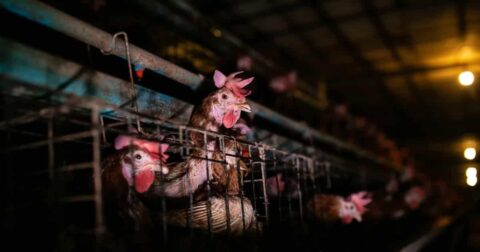News
Slaughterhouses Harbor Antibiotic-Resistant Bacteria That Give People Urinary Tract Infections
Food•6 min read
Explainer
The meat industry breeds chickens to grow as fast as possible. Here’s how they do it.


Words by Björn Ólafsson
Franken-chicken, fake chicken, GMO chicken, ultra-processed chicken, not-real chicken — there’s no shortage of ways to describe the 8 billion chickens raised and slaughtered in the U.S. factory farm system. But are any of these labels based in scientific reality, or are they just playing off the public’s distaste around humans tinkering with nature? It’s complicated. While there’s technically no such thing as GMO chickens, the use of selective breeding by the meat industry is a very real problem, both for public health and animal suffering.
The definition of a GMO, or genetically modified organism, isn’t a scientific one. As such, the description tends to vary depending on the source. The U.S. Environmental Protection Agency defines GMO as “a plant, animal, or microorganism that has had its genetic material (DNA) changed using technology that generally involves the specific modification of DNA, including the transfer of specific DNA from one organism to another. Meanwhile, the UN’s Food and Agriculture Organization or FAO defines it more specifically as “an organism in which one or more genes (called transgenes) have been introduced into its genetic material from another organism using recombinant DNA technology,” sometimes called rDNA.
In 2018, the U.S. Department of Agriculture announced rules for labeling GMOs as “bioengineered,” which the agency defines as foods genetically modified by using certain rDNA breeding techniques that “cannot be created through conventional breeding or found in nature.” The bioengineered label was created by USDA as a result of labeling laws passed by Congress two years earlier. Examples of GMOs include soy and corn, salmon and disease-resistant papaya. While most farm animals are not bred with GMO techniques, the vast majority are fed GMO corn and soy.
The evidence suggests that GMO crops are safe for human consumption, or at least as safe as the non-GMO version of the ingredient. At least 280 governmental organizations have reported that their top scientists have not found any health risks of GMO crops that aren’t found in conventional crops. Meta-analyses find the same thing: so-called GMOs present no detectable health or safety risks.
Despite the scientific consensus on the safety of these products, consumer surveys suggest that around half or more of consumers say they avoid GMOs (though their purchasing habits and answers to survey questions do not always align). Sometimes concerns about GMOs are driven by misinformation, while in other cases it might be perceptions and beliefs about naturalness in food, or health concerns about processed foods in general. Still other consumers object to corporate consolidation of power in the food system, though that’s not limited to GMO seed conglomerates like Bayer, which purchased Monsanto in 2018. Ultimately the term GMO, with that attention-grabbing word “genetic” right up top, seems like something out of a science fiction movie — it’s easy to imagine a horde of lab coat-clad scientists whipping up foods out of petri dishes.
Surveys suggest most anti-GMO consumers know less about food science than GMO-supporters — indicating that new and more accurate information could shift their attitudes.
While selectively bred, chickens have not been genetically modified, according to the USDA definition of GMO. It is worth noting that “GMO chicken” can sometimes mean a chicken who is fed GMO crops, not a chicken whose DNA has been modified. In this way, most chickens in the U.S. are GMO, because most U.S. crops are genetically modified.
Even though chickens have not endured gene-splicing or other technological manipulation, they have undergone selective breeding, which has indeed changed their biology in a way that is unnatural. The most obvious example is size; farmers historically bred larger chickens together, then mated their larger offspring with other larger birds. As a result, chickens have swollen from under a kilogram in the 1950s, to 4.2 kilograms today.
This extra weight causes a slew of welfare problems: lesions, foot injuries, broken bones, muscle atrophy and chronic pain being just a few. These broiler chickens were never experimented on in a lab, but their genetic traits have still been purposefully manipulated by humans to improve farmers’ bottom lines at the expense of animal welfare.
A true “GMO chicken” may be coming sooner than you’d think. For example, the idea of creating a strain of hens that only produce female offspring is being tossed around. This would prevent the need to grind alive baby male chicks in the egg industry, a practice routinely criticized as highly unethical.
More likely may be animals genetically edited to survive in hotter climates (a necessity for a warming planet, ironically fueled by animal farming itself). The USDA ruled last year that GMO cows would be safe for human consumption, and they may be hitting supermarkets by as early as next year.
No. According to USDA guidelines, organic chickens may not be fed any GMO crops.
Yes, most chickens in the U.S. are fed GMO crops like soy, corn or wheat.
“Non-GMO” is not a term regulated by the USDA but rather by a third-party non-profit, the Non-GMO Project. Symbolized by a butterfly label, this certification ensures the food company went through the verification process of the non-profit. “GMO-free” is not a regulated term.
According to the Genetic Literacy Project, a non-profit research organization that explores biotechnology, 41 countries are currently growing GMO crops. Of those, five countries — the United States, Canada, Brazil, Argentina and India — are responsible for 90 percent of the world’s GMO food crops.
Many countries have banned the growing of GMOs, while others have banned all imports of GMO products. However, most countries allow GMO crops to be fed to farmed animals in their borders, including the entire European Union, Peru, Venezuela, Saudi Arabia, Kenya and more. Only a few countries have formally banned the cultivation and importation of GMOs — Russia and Algeria.
By all evidence, GMO chicken (which again, simply means meat coming from an animal fed GMO crops) contains the same health advantages and disadvantages as chicken fed the same non-GMO feed.
While the evidence indicates that GMO crops are perfectly safe for human consumption, there are other aspects of our food system that should be giving consumers pause. For example, some farms’ abuse of antibiotics allow for antibiotic-resistant bacteria and microbes to flourish in chickens, which may be passed onto people who eat them. While the chicken industry uses far fewer antibiotics than the pork and beef industries, the overall reliance on antibiotics is a massive public health concern.
Many consumers make grocery selections in a neophobic way — that is, they tend to be resistant to novel foods and stick to what they find personally familiar. Even though the research into GMO foods finds no negative health effects, the media conversation around GMOs is relatively warped and prone to misinformation.
While most consumers shop based on health and taste, some people are considering the environmental costs of their foods. On this front, evidence for GMOs is more mixed. Because most GMOs are fed to “cows and cars” (i.e. feed for farmed animals or biofuel), it would be more environmentally sustainable to reduce our meat consumption and reliance on vehicles. Different types of GMOs can also increase or decrease pesticide use.
Though GMO crops are safe for human consumption, the vast majority of them are fed to farmed animals. With the exception of a type of farmed salmon, the farm animals themselves have not been genetically modified. They have been selectively bred to grow larger, fatter and faster, however, which causes these naturally playful birds to suffer health problems. In the future, the meat and dairy industries may push for breeding and marketing more GMO and gene-edited farm animals — with little assurance that the technology would be used to benefit animal welfare.